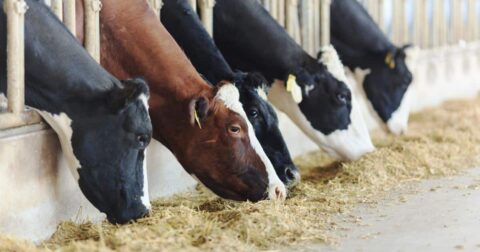Explainer
How Overconsumption Affects the Environment and Health, Explained
Climate•12 min read
Explainer
California may be out of its drought but millions of thirsty animals farmed in the west are still at risk. Just how much water does a cow drink anyway?


Words by Claire Hamlett
Some good news for California. The federal agency NOAA reports that a winter of heavy rains brought some relief as much of the state is no longer in extreme drought. But predictions aren’t entirely rosy. Researchers warn Oregon and Texas still face severe weather this spring, putting millions of animals at risk.
How much water does a cow drink each day anyway? That’s only part of the equation, it turns out. The amount of meat and milk we eat in the U.S. requires a whole lot of water — more than 72 billion gallons per year according to University of Nebraska scientists. It’s not just what the animal drinks, though each 1200 pound cow needs around 12 gallons every day — and twice that for a lactating dairy cow — but it’s the thirsty feed crops that are the real culprit, especially alfalfa.
Twenty-six million acres of alfalfa are grown and cut for hay in the U.S each year, particularly in the western U.S. According to a 2020 Nature Sustainability study, 79 percent of Colorado river water goes to irrigate crops, primarily feed crops like alfalfa.
Rampant water use to grow alfalfa for beef and dairy farms points to “beef and dairy consumption” as “the leading driver of water shortages and fish imperilment in the region,” the study finds. Low levels of water in the Colorado River Basin are directly tied to high levels of beef consumption in Los Angeles, Portland, Denver and San Francisco. Indeed, most feed crops go to domestic beef and dairy production.
Still, the U.S is exporting increasing amounts of feed crops too — particularly to China where demand for meat is on the rise. In 2021, alfalfa hay exports reached a record of 2.86 million metric tons.
Most of the alfalfa and other feed crops go to feed beef. According to the Nature study, a whopping two-thirds of these crops grown in the western U.S. are used to produce this red meat, with the remaining third going to dairy cows. In the U.S., 95 percent of cattle is fattened on grain, silage and hay for the last 160 to 180 days of their lives — which amounts to around 25 to 30 percent of their lifespan. Most dairy cows, by contrast, spend their whole lives indoors or in feedlots, fed a mix of grasses and irrigated crops such as alfalfa, corn and soy.
Feed crops are not the only reason these farms are so water-intensive. The beef and dairy industries also use a lot of water directly, though this accounts for a much smaller proportion of their overall water use. In both the western states and the U.S. as a whole, just watering livestock accounts for 2 percent of overall water consumption.
Much of the U.S. – including parts of California — are still in drought, and will continue to experience a dry spring and summer. It’s clear the amount of milk and meat in our diets puts a massive strain on water use and drives climate emissions.
Shifting to a more plant-rich sustainable diet can help us cut back on water use and greenhouse gases alike, scientists say, while doing nothing at all has alarming consequences. As Jack Schmidt, a professor and director of the Center for Colorado River Studies at Utah State University, told the Guardian, “we’re irrigating alfalfa in 120-degree temperatures in the dead of July … how does that possibly make any sense?”
This piece has been updated.